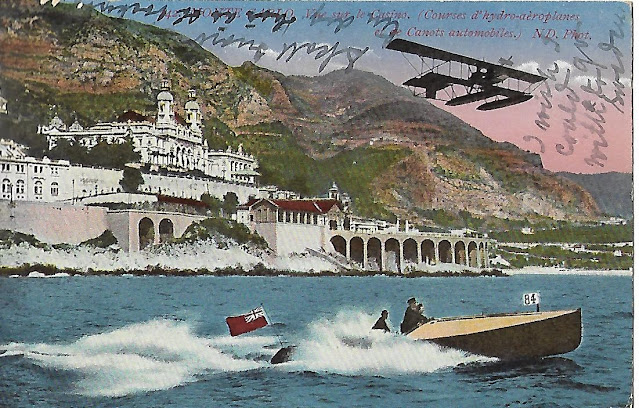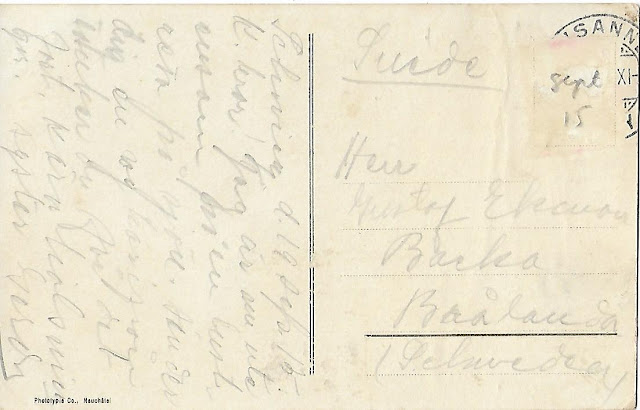 |
| ?42. MONTE CARLO. Vue sur le Casino. Courses d'hydro-aéroplanes et de Canots automobiles. ND Phot. |
Monte Carlo Casino "is a gambling and entertainment complex located in Monaco" [Wikipedia]
This card also features a hydro aeroplane and a motorboat.
"The first experimenter to succeed in making an aeroplane rise from the surface of the water was the French inventor, M. Fabre, who accomplished this feat with a monoplane of his own invention the last of March, 1910. About a year later Glenn Curtiss, at San Diego, fitted a float to his biplane and made it rise from the water and alight thereon with complete success during the course of his experiments." https://www.scientificamerican.com/article/the-hydro-aeroplane/
To: Mr. Gustaf Ekman, Backa, Brålanda, Suède (Sweden)
From: Gerda (Nice, 8.3.1916)
Nice, March 7.16 - D.B. [Dear Brother] Thank you very much for your letter today. Glad to hear from you that you are well. I am still writing to the Swedish-American soldier. Yes, he is very glad to have found somebody that cares for [him?] a little. Can you read this. Love, Gerda / I will write to you soon. It is so beautiful here. / I wish I could go with to Sweden. *
[* This PS written next to the aeroplane on the front of the card]
Nice, mars 7.16 - K.B. [Käre Broder] Tack så väldigt mycket för ditt brev idag. Glad att höra från dig att du mår bra. Jag skriver fortfarande till den svensk-amerikanske soldaten. Ja, han är glad att ha funnit någon som bryr sig om honom lite. Kan du läsa detta. Kära häls. Gerda / Skall snart skriva till dig. Här är så vackert. / Jag önskar jag kunde åka med till Sverige. *
[*Detta PS skrivet intill flygplanet på bilden.]
It seems that in some context, Gerda has come into contact with a Swedish-American soldier. I've not seen any other references to this among the postcards, so she must have mentioned him in a letter (as Gustaf has obviously asked if she's still in touch with him.) I'm feeling a bit puzzled about where she might have met him. America didn't enter the war until 1917. Were there American soldiers in France even before that? Or was this someone she had met before the war? Somehow it doesn't sound to me like she's referring to an acquaintance going back as far as to her years in America.
A few more searches, and I find an article entitled Over There, Before 1917.
"World War I essentially began Aug. 4, 1914, with the German army’s invasion of Belgium. The United States entered the conflict on the side of the Allies (Great Britain, Belgium, France, Italy and Russia) on April 6, 1917. During the intervening 32 months, America remained neutral – but many Americans did not. Thousands volunteered for the Allied cause."
Some of them joined the French Foreign Legion. As Americans, they could not swear allegiance to another country, but "in the Foreign Legion, one theoretically swore allegiance only to it, not to France".
"If anything characterized Americans who joined the Foreign Legion, it was their variety. They had only one common denominator: the desire to fight for France. [---] Some came from wealth, others did not; some were college graduates, others dropouts; some managed to at least graduate high school, and others did not. Some were black, others white. The Foreign Legion was the only military unit of World War I in which Americans of different races were comrades in arms."
And one of them, I suppose, may have been a Swedish American, with a bit of his heart still in Europe - or maybe just feeling he didn't have much left to lose, and no one to care for him?
A search for "French Foreign Legion Lyon" informs me that there is (now) a French Foreign Legion Recruiting Center in Lyon. I can't find the history, but it seems plausible that if they're there now, they were there back in WW1 as well.
As for how Gerda might have met him, the photo of her as a Red Cross volunteer comes to mind for me - previously posted here for Sepia Saturday 596. (Copying the photo below as well.) Date and place for the photo unknown, but as I now feel sure that Gerda lived in Lyon for the duration of the war (apart from occasional 'holiday' trips to Lake Geneva and the Riviera!), it seems likely that it was also in Lyon that she sometimes helped out as a Red Cross volunteer.
It's rather satisfactory when one manages to come up with a theory - even if I'll never know for sure! ;-)
G.085.02 - NICE
 |
| 34 - NICE - Avenue de la Gare |
To: Herr Gustaf Ekman, Backa, Brålanda, Suède
From: Gerda (Nice, 3 April 1916)
Nice d. 2. 4.16 - K.B. [Käre Bror] Det är visst länge sedan jag skrev till dig. Hur har du det, är du ännu kvar på samma plats. Vi äro nu här i härliga södern, 25 gr. varmt i solen i dag. Vi reser nog till Lyon igen om ett par veckor. Kära hälsningar, Gerda. / Jag undrar hur det går med vinsten?
Nice 2.4.16 - D.B. [Dear Brother] I think it's been a while since I last wrote to you. How are you, are you still staying at the same place? We are now here in the lovely south, 25 degrees in the sun today. We'll probably be going back to Lyon again in a couple of weeks. Love, Gerda. / I'm wondering how things are going with the winnings? *
*The Swedish word 'vinsten' could be interpreted either as winnings like from a lottery, or profit from an investment etc. As Gerda on previous postcards has been wondering about "luck" connected to the 15th of a few different months, I assume that she is still referring to some kind of lottery.
Compare the postcard from Sally in last week's post, written 27.3.1916. She too was wondering if Gustaf was still in the same place - or "if you have moved to your own farm now in March, or if you have sold your farm".





















































